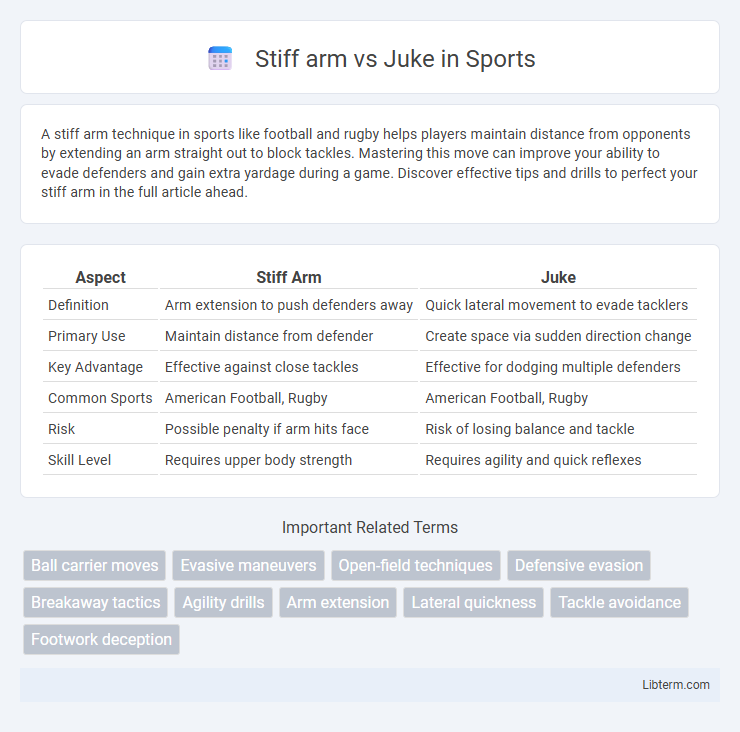A stiff arm technique in sports like football and rugby helps players maintain distance from opponents by extending an arm straight out to block tackles. Mastering this move can improve your ability to evade defenders and gain extra yardage during a game. Discover effective tips and drills to perfect your stiff arm in the full article ahead.
Table of Comparison
| Aspect | Stiff Arm | Juke |
|---|---|---|
| Definition | Arm extension to push defenders away | Quick lateral movement to evade tacklers |
| Primary Use | Maintain distance from defender | Create space via sudden direction change |
| Key Advantage | Effective against close tackles | Effective for dodging multiple defenders |
| Common Sports | American Football, Rugby | American Football, Rugby |
| Risk | Possible penalty if arm hits face | Risk of losing balance and tackle |
| Skill Level | Requires upper body strength | Requires agility and quick reflexes |
Introduction to Stiff Arm and Juke Moves
The stiff arm and juke moves are essential techniques in football for evading defenders. The stiff arm involves extending the arm to push away opponents, creating space and maintaining forward momentum. The juke is a quick, deceptive change of direction designed to mislead defenders and gain yards after contact.
Definition and Mechanics of the Stiff Arm
The stiff arm is a football technique where the ball carrier extends one arm straight out to fend off a defender, creating distance and preventing tackles. This maneuver relies on leverage and upper body strength to push away opponents effectively, maintaining forward momentum without losing speed or control. Unlike the juke, which involves rapid, deceptive footwork to evade defenders, the stiff arm emphasizes physical power and balance to break tackles.
Definition and Mechanics of the Juke
The juke is a quick lateral footwork move used by ball carriers to evade defenders by shifting their body weight and rapidly changing direction while maintaining speed. Unlike the stiff arm, which employs an extended arm to push defenders away, the juke relies on agility, deception, and sudden cuts to create separation. Effective juking requires explosive lower-body strength, precise timing, and sharp hips to maximize evasion and maintain balance.
Historical Origins in Football
The stiff arm, rooted in early 20th-century American football, emerged as a fundamental technique used by running backs to fend off tacklers by extending the arm to maintain distance. The juke, tracing back to African American players in the Southeastern United States during the 1920s, developed as a deceptive footwork move to evade defenders through sharp, misleading directional changes. Both techniques have evolved through decades of gameplay and remain iconic, reflecting the sport's emphasis on agility and physicality in ball carrier strategies.
Key Differences Between Stiff Arm and Juke
The key differences between a stiff arm and a juke lie in their execution and purpose on the football field. A stiff arm involves extending the arm to fend off a defender while maintaining forward momentum, emphasizing strength and reach to create separation. In contrast, a juke is a sudden, deceptive lateral movement designed to evade tackles by changing direction quickly, relying on agility and footwork rather than arm extension.
Situational Effectiveness on the Field
The stiff arm excels in close-quarters situations by allowing ball carriers to maintain forward momentum while warding off defenders, making it highly effective in short-yardage and goal-line scenarios. The juke offers superior agility and evasion in open-field plays, enabling quick directional changes that confuse defenders and create significant yardage gains. Choosing between a stiff arm and a juke depends on the defender's positioning and the available space on the field, with the stiff arm favored in congested areas and the juke optimal for open, fast-paced situations.
Physical Requirements for Each Move
The stiff arm demands significant upper body strength and arm extension to fend off defenders, relying on robust shoulder and arm muscles for effective resistance. In contrast, the juke requires exceptional lower body agility, balance, and quick footwork, engaging core and leg muscles to execute sudden directional changes. Both techniques necessitate explosive power, but the stiff arm emphasizes upper body conditioning, while the juke focuses on dynamic lower body coordination.
Training Drills for Stiff Arm and Juke
Training drills for the stiff arm emphasize strength and arm extension techniques using resistance bands and tackling dummies to simulate defensive pressure. Juke drills focus on agility and quick footwork through cone drills and ladder exercises that enhance lateral movement and change of direction speed. Both techniques benefit from reaction time improvement drills to maximize effectiveness in evading defenders.
Famous Players Known for Stiff Arm vs Juke
Famous players known for their masterful stiff arms include Bo Jackson and Cam Newton, whose powerful arm extensions consistently bulldozed defenders to gain extra yards. In contrast, legends like Barry Sanders and Odell Beckham Jr. excelled at jukes, using agile footwork and deceptive cuts to evade tackles and create explosive plays. Both techniques remain vital skill sets, showcasing the diverse athleticism required for elite football performance.
Choosing the Right Move: Stiff Arm or Juke
Choosing between a stiff arm and a juke depends on the defender's positioning and your speed; a stiff arm is effective for pushing away close defenders and maintaining momentum, while a juke excels at evading tackles through quick, deceptive lateral movements. The stiff arm leverages upper body strength to create separation, especially in short-yardage or goal-line situations. Conversely, a juke relies on agility and footwork, making it ideal for open-field scenarios where rapid changes of direction can exploit defensive gaps.
Stiff arm Infographic

 libterm.com
libterm.com